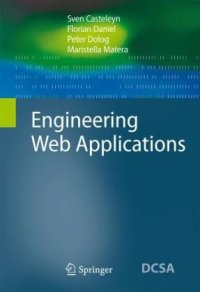
Ebook: Engineering Web Applications
- Genre: Technique
- Tags: Software Engineering, Models and Principles, Information Systems Applications (incl.Internet), Business Information Systems, Management of Computing and Information Systems
- Series: Data-Centric Systems and Applications
- Year: 2009
- Publisher: Springer-Verlag Berlin Heidelberg
- Edition: 1
- Language: English
- pdf
Nowadays, Web applications are almost omnipresent. The Web has become a platform not only for information delivery, but also for eCommerce systems, social networks, mobile services, and distributed learning environments. Engineering Web applications involves many intrinsic challenges due to their distributed nature, content orientation, and the requirement to make them available to a wide spectrum of users who are unknown in advance.
The authors discuss these challenges in the context of well-established engineering processes, covering the whole product lifecycle from requirements engineering through design and implementation to deployment and maintenance. They stress the importance of models in Web application development, and they compare well-known Web-specific development processes like WebML, WSDM and OOHDM to traditional software development approaches like the waterfall model and the spiral model. Important problem areas inherent to the Web, like localization, personalization, accessibility, and usage analysis, are dealt with in detail, and a final chapter provides both a description of and an outlook on recent Semantic Web and Web 2.0 developments.
Overall, their book delivers a comprehensive presentation of the state-of-the-art in Web application development and thus forms an ideal basis for academic or industrial courses in this or related areas. It is equally suitable for self-study by researchers or advanced professionals who require an overview on how to use up-to-date Web technologies.
Nowadays, Web applications are almost omnipresent. The Web has become a platform not only for information delivery, but also for eCommerce systems, social networks, mobile services, and distributed learning environments. Engineering Web applications involves many intrinsic challenges due to their distributed nature, content orientation, and the requirement to make them available to a wide spectrum of users who are unknown in advance. The authors discuss these challenges in the context of well-established engineering processes, covering the whole product lifecycle from requirements engineering through design and implementation to deployment and maintenance. They stress the importance of models in Web application development, and they compare well-known Web-specific development processes like WebML, WSDM and OOHDM to traditional software development approaches like the waterfall model and the spiral model. Important problem areas inherent to the Web, like localization, personalization, accessibility, and usage analysis, are dealt with in detail, and a final chapter provides both a description of and an outlook on recent Semantic Web and Web 2.0 developments. Overall, their book delivers a comprehensive presentation of the state-of-the-art in Web application development and thus forms an ideal basis for academic or industrial courses in this or related areas. It is equally suitable for self-study by researchers or advanced professionals who require an overview on how to use up-to-date Web technologies.